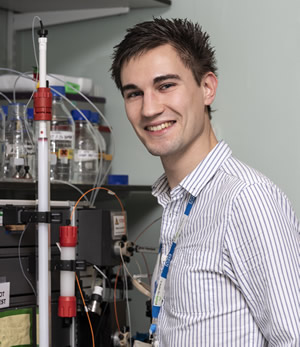Dr. Chris Hillby Meaghan Sullivan  Dr. Chris Hill is a post-doctoral researcher in Dr. Ian Brierley’s lab at the University of Cambridge, England. Dr. Hill received his bachelor’s degree in Natural Sciences from Queens’ College, Cambridge before embarking on a combined Masters and PhD program in Biomedical Sciences through the Wellcome Trust at the University of Cambridge. He joined the Wellcome Trust Infection and Immunity graduate program because he had “always been fascinated by disease processes and host-pathogen interactions—not just from a human health perspective but also because of how much we can learn about basic cell biology by studying how a system responds to perturbation during infection.” The Wellcome Trust MSc-PhD program also gave him the opportunity to find his scientific direction. “During my Master’s,” he said, “I did three rotation projects in different labs, which really helped me decide what sort of a scientist I was.” Actually, Dr. Hill did not start his scientific career in RNA biology. His PhD in Dr. Janet Deane’s lab focused on mechanisms of sphingolipid degradation by β-galactocerebrosidase (GALC). He solved the structure of the glycosphingolipid-processing complex by X-ray crystallography, describing key steps in the hydrolysis of lipids. “It was the perfect PhD project,” he said. “Studying GALC allowed me to get extensive training in structural biology from a brilliant group of people. It was also an achievable and realistic project, and, at the time, a relatively neglected area of biology so I felt that one graduate student could make a real impact.” But he remained inspired by his Master’s work on viruses, and so, when he was deciding on a post-doc position, he decided to “revisit RNA biology, and at the same time, work on a more ambitious structural project involving large multi-protein complexes.” Dr. Hill joined Dr. Lori Passmore’s lab at the Medical Research Council (MRC) Laboratory of Molecular Biology (LMB) in Cambridge to train in cryo-electron microscopy. The Passmore lab “provides a great environment to learn both RNA biology and high-resolution cryo-EM.” Even though that changing fields was not straightforward, he enjoyed working with “a fantastic group of people on a very interesting project: structure and mechanism of the cleavage and polyadenylation factor complex.” When his work on cleavage and polyadenylation led to a structure that “generated insight into how the Influenza NS1 protein interferes with the process,” he became fascinated by how viruses subvert information transfer in cells.
Dr. Hill then joined the Brierley lab because it allowed him to study RNA biology in the context of his passion for viruses. Currently, Dr. Hill is most excited about his project on how Cardiovirus affects the translational machinery. He said, “For something so small (15 kDa), the Cardiovirus 2A protein messes up the host cell in amazing ways. It stimulates ribosomal frameshifting, inhibits cap-dependent translation initiation, dysregulates nuclear import/export, and interferes with apoptosis. Its ability to bind both viral and ribosomal RNA is central to these activities – and I want to understand the mechanisms involved.” In addition, he continued, “One of the challenges I have particularly enjoyed is establishing a structural biology program from scratch in the Brierley lab. This has given me a great deal of operational independence.” Dr. Hill is also very active outside of the lab. He teaches undergraduates weekly, sits on the departmental Equality, Diversity, and Well-being panel, and organizes weekly virology seminars. He also finds balance in his busy life by keeping up with his artistic passion for being a composer, and some of his work is even available on YouTube. One of his science heroes is Dr. Deane, his PhD advisor. Because he joined the lab when it was young, he got to spend time with her at the bench. He explained, “we would chat about science all the time, and she would frequently challenge my ideas in a very constructive way. She would also talk to me honestly and openly about the problems that she had encountered in her career. Working with her made me the scientist I am today.” For trainees, he emphasized the importance of “choosing a supportive lab where you know you can learn best-practice experimental skills. These will be the foundation of your career, and it’s much easier to learn from a competent practitioner than it is from reading a methods paper.” He continued, “Collaborate. Help each other out. You don’t get extra points for doing it all on your own. Go to seminars and ask questions. Discuss ideas with colleagues. Don’t hide failures; be honest about mistakes. Be kind to yourself and others.” Currently, Dr. Hill’s favorite RNA is the coronavirus pseudoknot that stimulates frameshifting. Although he has only been to one RNA society meeting, he is excited to attend more! Learn more about him on twitter (@chillzaa). |
